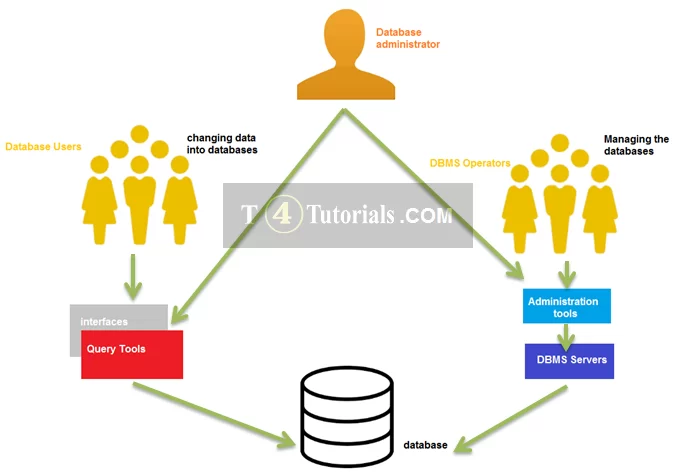Explain Different Types of Database Users in Dbms
Database Administrator DBA. It Handles the local queries.

Database Users T4tutorials Com
The database users also can be categorized again into five groups according to how they interact with the database.

. Multimedia DBMS Stores data such as text images audio video and 3D games which are usually stored in binary large object. They are the developers who develop the complex programs to the requirement. Types of DBMS Tha main Four Types of Database Management System are.
They are the SQL programmers who are going to deal directly with the database. For example Elasticsearch nominally a search engine database provides enough of the core operations on documents to be categorized as a document-oriented database. They are also often used in browsing interface which allow a user to look through the contents of a database in an exploratory and unstructured manner.
They use a sophisticated database query language basically to specify their request and are typically middle or level managers or other occasional browsers. Structured Query Language SQL A programming language generally used for the relational database management system which comprises tables. The application programs could be written in high level language.
The casual end users access the database occasionally. Databases with the same base hardware and running on the same operating systems and applications are known as homogeneous DDBs. Each time they access the database their request will change.
In different sites of the DDB defined as a heterogeneous DDB operating systems the underlying hardware and application procedures can be different. They use sophisticated database query language to retrieve the data from the database. 1 Centralized Database It is the type of database that stores data at a centralized database system.
As its name shows application programmers are the one who writes application programs that. It comforts the users to access the stored data. Users in DBMS There are different types of users and can retrieve data on demand using the applications and interfaces provided by DBMS.
Stand-alone Users - These users will have stand alone database for. We have different data models by which we can store the dataYou can read more about the different types of data model from here. Forms-Based Interfaces A forms-based interface displays a form to each user.
Many popular databases currently in use are based on the relational database model. A DBMS has appropriate languages and interfaces to express database queries and updates. The DBA has.
RDBMSs have become a predominant choice for the storage of information. Let us take an example where we use the relational model for storing the data. They use the developed applications and.
This data is based on other means than the table relationships in reference databases. Data is Stored Hierarchically top down or bottom up format. We have to store the data of a student the columns in the student table will be student_name age mail_id roll_no etc.
The different types of end users are as follows. Pull-down menus are a very popular technique in Web based interfaces. Codd of IBMs San Jose Research Laboratory.
Just as in any hierarchy this database follows the progression of data being categorized in ranks or levels wherein data is categorized based on a common point of linkage. It is used to define database structure or pattern. Types of Users Sophisticated Users.
End user The users who deal with the database at the terminal end they can be casual users or native database user. Types of DBMS Relational database. Native Users Application Programmers Sophisticated Users Specialized Users Stand-alone Users 1.
End users are those who access the database from the terminal end. Naive or parametric end users. Types of Database Language 1.
Database languages can be used to read store and update the data in the database. A relational database management system RDBMS is a database management system DBMS that is based on the relational model as invented by E. Hierarchical database Network database Relational database Object-Oriented database Hierarchical DBMS In a Hierarchical database model data is organized in a tree-like structure.
Specialized Users - These are also sophisticated users but they write special database application programs. JSON documents can be stored as a string in a key-value store or relational database. DDL stands for Data Definition Language.
Document stores can use internal notations such as JSON which are processed directly. Types of Databases There are various types of databases used for storing different varieties of data. NoSQL Database A NoSQL which originally means a non-relational database or non-SQL provides a data storage and recovery mechanism.
Data Manipulation Languages DML This is a programming language used to insert or modify the data present in a database These are of two types. Types of DBMS Database Management System We will now see DBMS types one by one that are explained below. Different Types of Database Users in DBMS Application Programmers.
Mobile DBMS Runs on the smartphones tablets. These users learn very few facilities that they may use repeatedly from the multiple facilities provided by DBMS to access it. GIS DBMS Stores and queries the spatial data.
Native Users These are the database users who are communicating with the database through an already written program. Sensor DBMS Allows to manage sensor data bio-metric and telematics data. Hierarchical databases Network databases Object-oriented databases Relational databases NoSQL databases 1.
Heterogeneous and homogenous are the two kinds of distribution database.

Database Users And Administrator Ducat Tutorials


Comments
Post a Comment